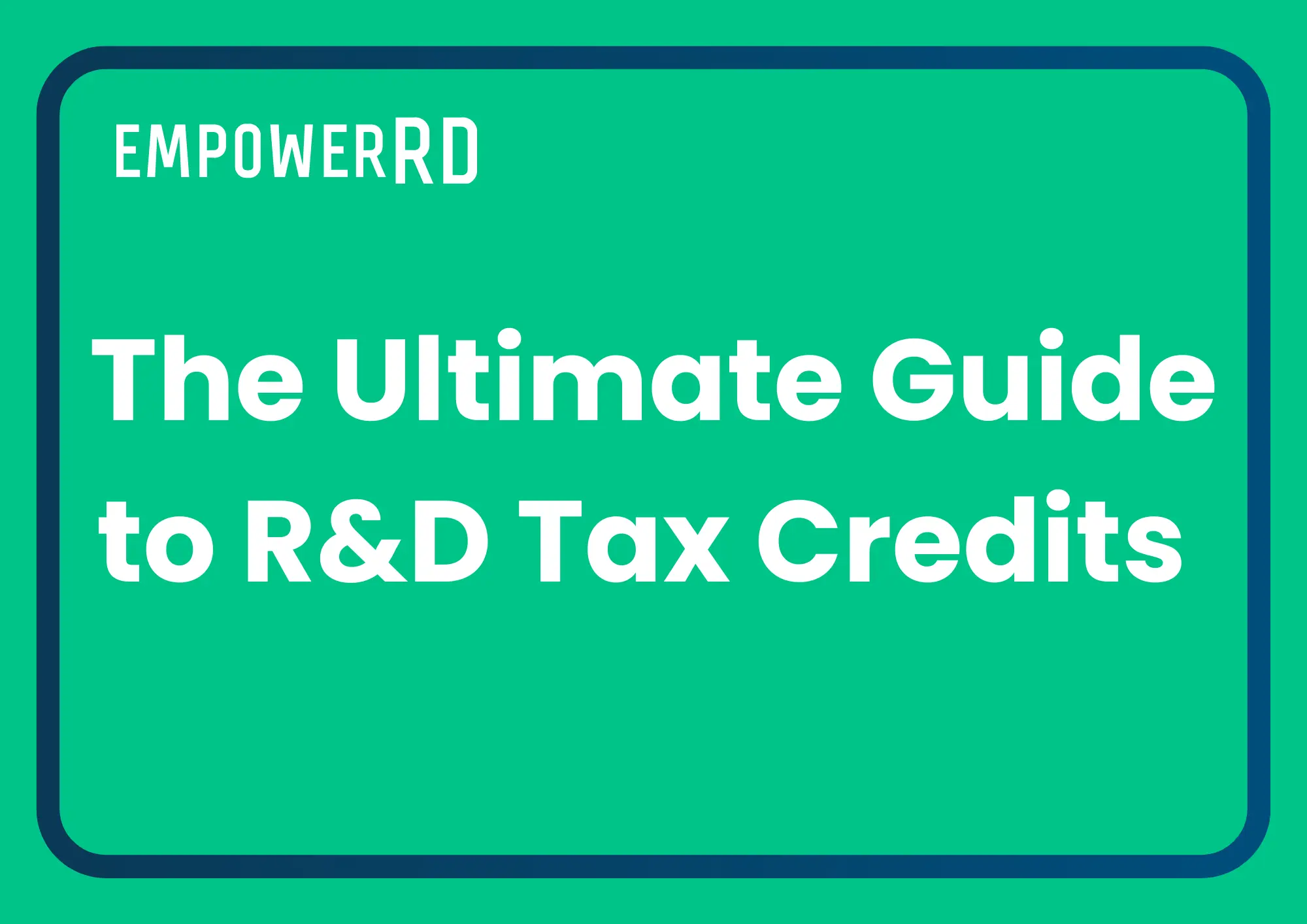
An agile platform to adapt to changing regulations. A team of R&D tax claim and sector specialist: ex-HMRC, ATT qualified, AML trained, AML registered and supervised by HMRC.
Book a Meeting
Home R&D Tax Credits
R&D Tax Credits in the UK: The Ultimate Guide
Everything you need to know about the R&D tax credit scheme from HMRC: a complete guide for new claimants.
In the UK, Research and Development (R&D) Tax Credits are one of the most generous incentives offered by the government to encourage businesses to innovate.
They help to offset R&D costs, either through a Corporation Tax reduction or a direct cash payment. This gives you vital funds for your business to grow.
In this guide, we’ll cover:
- What are R&D tax credits and why they matter
- Whether your company qualifies for R&D tax relief
- Qualifying costs that you can include in your R&D tax claim
- R&D schemes and how they work (SME, RDEC, merged scheme, ERIS)
- Steps to make a successful R&D claim
What are R&D tax credits?
R&D tax credits are a UK government incentive, designed to encourage innovation by rewarding UK businesses that tackle scientific or technological challenges.
If you’re developing a new product, improving a process, or enhancing software, your company may qualify for R&D tax relief.
With R&D tax credits, a share of your qualifying R&D expenditure will be returned to your company, either as a Corporation Tax deduction or as a payable credit. The share ranges from around 8% of your costs to upwards of 27%, depending on the scheme and your company’s financial situation.
Any UK limited company can qualify for R&D tax relief, no matter the sector or size. You’ll need to have eligible R&D projects that focus on resolving scientific or technological uncertainties that a competent professional in the field wouldn’t readily be able to solve.
R&D Credit Eligibility
HMRC’s definition of R&D focuses on whether your project addresses a gap in scientific or technological knowledge. You’ll need to show that you set out to advance science or technology and that you faced uncertainties that couldn’t easily be resolved by a specialist (competent professional) in that field.
There are four key criteria that define R&D for tax purposes:
- New or Improved product: If your business is developing a new or improved product, tool or service, you could be carrying out R&D.
- Aiming for a scientific or technological advance: You’re pushing the boundaries of what is commonly known in your field.
- Facing scientific or technological uncertainties: A competent professional wouldn’t already know the solution from existing knowledge or publicly available data.
- Competent professionals leading the work: Skilled engineers, developers, researchers, or scientists guide or carry out the R&D.
Further reading: Is my business eligible for R&D tax credits?
Qualifying R&D Costs
For your R&D tax credits claim, you’ll need to identify your qualifying R&D costs (expenses that are directly linked to your R&D projects). HMRC groups these costs into distinct categories, each of which is governed by specific criteria. The most common categories of R&D costs are listed below:
| Types of R&D Costs | Examples |
|---|---|
| Staff Costs | Salaries, employer National Insurance, and pension for R&D-focused staff |
| Consumables | Materials, chemicals, utilities (power, water) used in R&D |
| Subcontractors | External specialists contracted for R&D tasks |
| Software & Cloud | Software licenses, hosting, or cloud costs used primarily for R&D |
| Externally Provided Workers | Temporary or agency workers under your supervision |
If your R&D staff also spend some time on non-R&D tasks, you’ll need to apportion their costs (e.g., if an employee spends 60% of their time on R&D, you claim 60% of their salary). Keeping clear and detailed records will make your claim more robust and reduce any risk of enquiry.
R&D Tax Credit Schemes & Rates
There are a number of different R&D tax credit schemes. Your company’s size, financial position (profit or loss), and accounting period start date will determine how much R&D relief you can claim.
Accounting periods starting on or after 1 April 2024
Recent government reforms have introduced a merged R&D Expenditure Credit scheme for periods beginning on or after 1 April 2024, plus an ERIS scheme for R&D-intensive loss-making SMEs.
| R&D Scheme (from 1st Apr 2024) | Who It’s For | Approx. Net Benefit |
|---|---|---|
| Merged R&D Expenditure Credit | Default for all companies doing qualifying R&D | ~14.7%–16.2% of qualifying spend |
| Enhanced R&D Intensive Support (ERIS) | Loss-making SMEs with at least 30% of total costs as R&D | 12.5%–27% of qualifying spend |
Accounting periods beginning before 1 April 2024
For accounting periods that start before 1 April 2024, the Research and Development Expenditure Credit (RDEC) and Small-Medium Enterprise (SME) schemes apply:
| R&D Scheme (before 1st Apr 2024) | Who It’s For | Approx. Net Benefit |
|---|---|---|
| SME Scheme | Most small/medium UK companies | Up to 27% |
| RDEC Scheme | Large companies and some SMEs (e.g., grant-funded) | ~15% net |
Making a R&D Tax Credit Claim
Making a R&D tax credits claim may seem daunting, but breaking it down into manageable steps helps. Here’s an overview:
1. Identify your R&D projects
Pinpoint the projects that meet HMRC’s definition of R&D. Gather evidence such as project plans, technical specs, emails discussing uncertainties, etc.
2. Choose the right scheme
Check your accounting period start date, and evaluate your company size and whether you’re profitable or loss-making.
- If your accounting period start date is after April 2024, you will be under the merged RDEC scheme (or ERIS if you’re a loss-making, R&D-intensive SME).
- If your accounting period is before April 2024 and your business has fewer than 500 staff with a turnover under €100m or a balance sheet total under €86m, you’ll likely claim through the SME scheme. Larger businesses with 500+ staff and turnover above €100m will likely claim through the RDEC scheme.
3. Submit a claim notification, if required
From 1 April 2023, first-time claimants or companies that haven’t claimed in 3+ years must submit a Claim Notification Form within 6 months of their period-end.
This also applies if you’re amending a previous return post-1 April 2023 to add R&D relief for the first time.
4. Complete the Additional Information Form
Introduced in August 2023, the Additional Information Form (AIF) is now mandatory for every R&D tax claim. It summarises your R&D expenditure, the nature of your projects, and key details like the main “competent professionals.”
5. Prepare an R&D claim report
Although HMRC doesn’t mandate a technical “report,” it’s strongly recommended. This document explains your R&D in detail and can significantly reduce the risk of an enquiry.
6. File or amend your CT600 + CT600L
- Incorporate the R&D figures (enhanced costs, credit calculations) into your Company Tax Return (CT600).
- Use the CT600L pages to detail your R&D claim under SME, RDEC, or the merged schemes.
- If all goes well, HMRC will process and approve your claim, issuing you with either a reduced Corporation Tax bill or a direct cash payout.
Additional Resources
- In-House, Accountant, or Advisor? Learn which approach best suits your claim complexity, budget, and internal expertise.
- How Far Back Can I Claim?
If you’ve missed claiming in prior years, you might still be able to reclaim R&D expenses for up to two accounting periods. - R&D Tax Credits for Loss-Making Companies:
Get more detail on the rates and considerations for unprofitable businesses—particularly relevant for start-ups. - Grant Funding & Tax Credits: Understand how public grants and subsidies interact with R&D tax relief and if they affect which scheme you use.
Frequently Asked Questions
1. How long does it take to receive R&D tax credits once I file my claim?
- HMRC used to target a 28-day turnaround for SME claims, but processing can currently take closer to 40 days or more. Delays often happen if HMRC requests additional documentation. Ensuring your submission is complete and accurate can speed up the process.
2. Can I claim for failed projects or prototypes that didn’t work out?
- Absolutely. The R&D tax credit scheme focuses on the attempt to resolve scientific or technological uncertainties, not the outcome. Even unsuccessful R&D can qualify if it meets HMRC’s criteria.
3. Do I need to claim for R&D tax credits every year, or can I skip a year and claim later?
- You can include R&D costs in your CT600 for that specific accounting period. If you discover missed R&D in a prior period, you can usually amend your Company Tax Return within two years of the period’s end (although claim notification rules might now apply).
4. What if only part of a project meets R&D criteria?
- You can still claim for the eligible portion. Carefully separate the R&D-related costs from non-R&D activities. Documentation is crucial here—keep time sheets or project logs that allocate staff hours and consumables used specifically for R&D.
Talk to an R&D specialist
Still unsure whether your projects qualify or how recent scheme changes affect you?
EmpowerRD has helped over 1,200 UK companies claim more than £250m in R&D tax relief. Our team includes ex-HMRC inspectors and seasoned R&D advisors who’ll ensure your claim is both optimised and compliant. Contact us to discuss your R&D projects or continue exploring our R&D Tax Credits guide for deeper insights on eligibility, costs, and claim mechanics.
About the author
Alex Hannaway
Alex Hannaway is the Content Marketing Manager at EmpowerRD, where he has played a pivotal role for over three years in shaping the company’s content strategy and ensuring it aligns with the latest developments in R&D tax credits. With an in-depth understanding of R&D tax relief, Alex ensures that EmpowerRD’s messaging is accurate, clear, and up-to-date with the latest legislation and reforms. His expertise in creating compelling content helps innovative companies navigate the complexities of the R&D tax credit landscape, positioning EmpowerRD as a trusted partner for businesses seeking to optimise their claims.
Talk to an expert
Our clients say
"The online platform made it much easier to co-ordinate between the finance and technical teams."

“EmpowerRD is doing R&D claims the way everyone should be doing it. They absolutely exceeded our expectations and are now one of our long term partners.”

“I was looking for a specialist with a rigorous platform that could handle a complex R&D tax credit claim, because of our grant. EmpowerRD came up on top.”

“Whilst the platform was a real asset for us, the best thing was the support we received. We always had a client success manager on the other end. If we had any questions or concerns, we could use the chatbot, and our client success manager was there to help. It was a breeze; really good support throughout.”
Join our newsletter
Stay informed
By subscribing you agree to with our Privacy Policy and provide consent to receive updates from our company.
Useful Links
© Copyright. EmpowerRD. CN 10785149. VAT GB 271357893. All Rights Reserved. Registered office: 5th Floor, Holden House, 57 Rathbone Place, London W1T 1JU.




